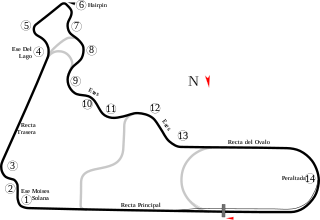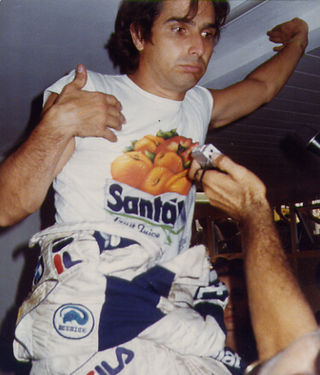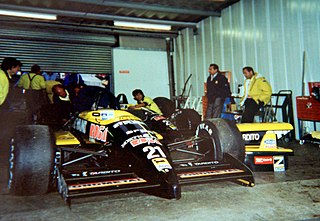
Riccardo Gabriele Patrese is an Italian former racing driver, who competed in Formula One from 1977 to 1993. Patrese was runner-up in the Formula One World Drivers' Championship in 1992 with Williams, and won six Grands Prix across 17 seasons.

Edward McKayCheever Jr. is an American former racing driver who raced for almost 30 years in Formula One, sports cars, CART, and the Indy Racing League. Cheever participated in 143 Formula One World Championship races and started 132, more than any other American, driving for nine different teams from 1978 through 1989. In 1996, he formed his own IRL team, Team Cheever, and won the 1998 Indianapolis 500 as both owner and driver. The team later competed in sports cars.

The 1984 Italian Grand Prix was a Formula One motor race held at Monza on 9 September 1984. It was the fourteenth race of the 1984 Formula One World Championship.

The 1985 Australian Grand Prix was a Formula One motor race held on the Adelaide Street Circuit in Adelaide on 3 November 1985. The sixteenth and final race of the 1985 Formula One World Championship, it was the 50th running of the Australian Grand Prix and the first to be held on the streets of Adelaide on a layout specifically designed for the debut of the World Championship in Australia. The race was held over 82 laps of the 3.780 km (2.362 mi) circuit for a total race distance of 310 kilometres. The race was won by Keke Rosberg driving a Williams-Honda; this was the final win for Rosberg, the last race for Alfa Romeo until 2019, and the last by a Finnish driver until Mika Häkkinen won the 1997 European Grand Prix.

The 1988 Mexican Grand Prix was a Formula One motor race held on 29 May 1988 at the Autódromo Hermanos Rodríguez, Mexico City. It was the fourth race of the 1988 Formula One World Championship. The 67-lap race was won by Alain Prost, driving a McLaren-Honda, with teammate Ayrton Senna second and Gerhard Berger third in a Ferrari.

The 1988 Australian Grand Prix was a Formula One motor race held at the Adelaide Street Circuit on 13 November 1988. It was the sixteenth and final race of the 1988 Formula One World Championship, and the last race for which turbocharged engines would be eligible until the 2014 Australian Grand Prix.

The 1989 United States Grand Prix was a Formula One motor race held in Phoenix, Arizona on June 4, 1989. It was the fifth race of the 1989 Formula One World Championship and the first United States Grand Prix to be held in Phoenix.

The 1988 FIA Formula One World Championship was the 42nd season of FIA Formula One motor racing. It featured the 1988 Formula One World Championship for Drivers and the 1988 Formula One World Championship for Constructors, which were contested concurrently over a sixteen-race series that commenced on 3 April and ended on 13 November. The World Championship for Drivers was won by Ayrton Senna, and the World Championship for Constructors by McLaren-Honda. Senna and McLaren teammate Alain Prost won fifteen of the sixteen races between them; the only race neither driver won was the Italian Grand Prix, where Ferrari's Gerhard Berger took an emotional victory four weeks after the death of team founder Enzo Ferrari. McLaren's win tally has only been bettered or equalled in seasons with more than sixteen races; their Constructors' Championship tally of 199 points, more than three times that of any other constructor, was also a record until 2002.

The 1984 FIA Formula One World Championship was the 38th season of Fédération Internationale de l'Automobile (FIA) Formula One motor racing. It featured the 1984 Formula One World Championship for Drivers and the 1984 Formula One World Championship for Manufacturers, both of which commenced on 25 March and ended on 21 October after sixteen races.

The 1983 FIA Formula One World Championship was the 37th season of FIA Formula One motor racing. It featured the 1983 Formula One World Championship for Drivers and the 1983 Formula One World Championship for Manufacturers, which were contested concurrently over a fifteen-race series that commenced on 13 March and ended on 15 October.

The 1981 FIA Formula One World Championship was the 35th season of FIA Formula One motor racing. It featured the 1981 Formula One World Championship for Drivers and the 1981 Formula One World Championship for Manufacturers, which were contested over a fifteen-race series that commenced on 15 March and ended on 17 October. The 1981 South African Grand Prix, as a non-championship race due to difficulties from the ongoing FISA–FOCA war, was open to Formula One entrants but was not part of the World Championship.
Osella is an Italian racing car manufacturer and former Formula One team. They participated in 132 Grands Prix between 1980 and 1990. They achieved two points finishes and scored five world championship points.

The Alfa Romeo 75, sold in North America as the Milano, is a compact executive car produced by the Italian automaker Alfa Romeo between 1985 and 1992. The 75 was commercially quite successful: in only three years, 236,907 cars were produced, and by the end of production in 1992, around 386,767 had been built.

The Alfa Romeo 185T is a Formula One car that Alfa Romeo used during the 1985 season. The car was entered in 8 races, but without any success and suffering from poor reliability, the team returned to the previous year's car, the 184T, updated to 184TB specification.

The Alfa Romeo 183T was a Formula One car designed by Gérard Ducarouge and Mario Tollentino and was used by Marlboro Team Alfa Romeo during the 1983 Formula One season. The car, with a newly designed flat bottom, made its debut at the 1983 Brazilian Grand Prix. Running on Michelin tyres, the 183T was driven in 1983 by Italian drivers Andrea de Cesaris and Mauro Baldi.
Italian motor manufacturer Alfa Romeo has participated multiple times in Formula One. The brand has competed in motor racing as both a constructor and engine supplier sporadically between 1950 and 1987, and later as a commercial partner between 2015 and 2023. The company's works drivers won the first two World Drivers' Championships in the pre-war Alfetta: Nino Farina in 1950 and Juan Manuel Fangio in 1951. Following these successes, Alfa Romeo withdrew from Formula One.

The Ligier JS29 was a Formula One car designed by Michel Têtu and Michel Beaujon for the Ligier team for use in the 1987 season. It was originally developed for use with an Alfa Romeo turbo power plant but prior to the start of the season, Ligier lost the use of the engine. The car had to be re-designed around a Megatron Straight 4 turbo engine. Redesignated the JS29B, it scored a single point during the season when driver René Arnoux finished 6th in the Belgian Grand Prix. Later in the season, the car was further refined to a JS29C specification.

The Brabham BT50 was a Formula One racing car designed by Gordon Murray and powered by a turbo BMW engine. It was raced by the Brabham team, owned by Bernie Ecclestone, during the 1982 Formula One season. Driven by Nelson Piquet and Riccardo Patrese, it made its debut at the South African Grand Prix before being withdrawn for further development of its engine while the team reverted to the previous year's car, the Brabham BT49. On the reintroduction of the BT50, Piquet finished fifth in the Belgian Grand Prix. A few races later he drove it to a win in the Canadian Grand Prix. Later in the year it achieved three more finishes in the points for the team. During the second half of the season, Brabham implemented the strategy of mid-race refueling. This allowed Piquet and Patrese to start the races relatively light and use their reduced weight to gain track position over their competitors before stopping to refuel. The poor reliability of the BT50 meant that they had only a few opportunities to demonstrate the strategy in practice.

The Osella FA1L was a Formula One car designed by Antonio Tomaini and raced by Osella in the 1988 FIA Formula One World Championship. The car was the last Osella to be powered by a turbocharged engine, the 1.5-litre V8 named the Osella 890T. The car was driven by young Italian Nicola Larini who had made his F1 debut with Coloni in 1987.

Alfa Romeo has made three 8-cylinder Grand Prix racing engines designed for both Formula One and sports car racing; in both inline and V engine configurations. Their first was the supercharged 158/159, a straight-eight engine, with the 1.5 L engine configuration imposed by the FIA for forced induction engines, in 1950. After a 20-year gap, their second engine was the Tipo 33 engine, a 3-liter naturally-aspirated V8 engine, in 1970. Their third and final engine was the turbocharged 890T V8 engine in 1983, which was used by both Alfa Romeo until 1985, and Osella until 1988, until Alfa Romeo eventually pulled out of F1 that same year.

















